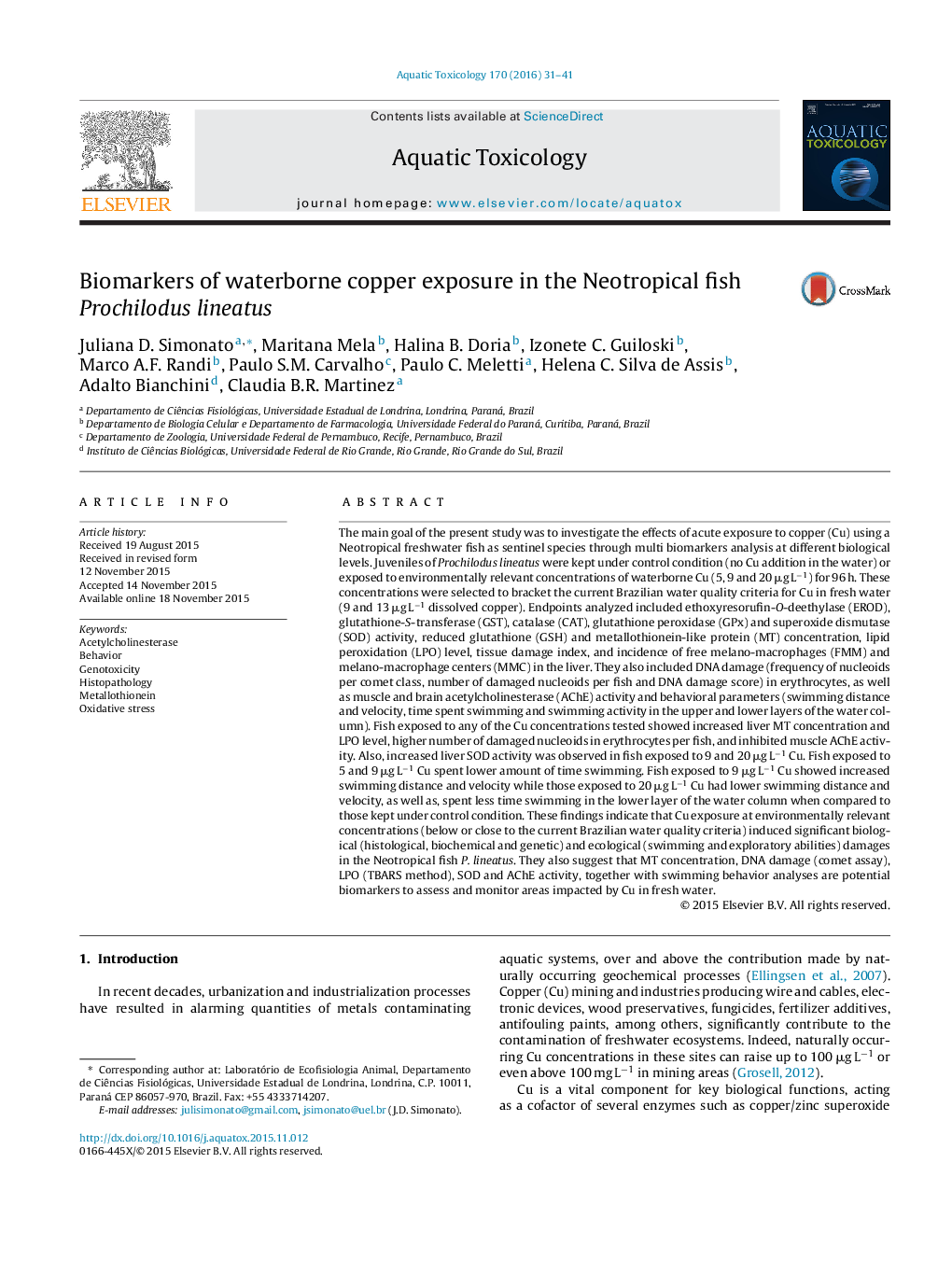| کد مقاله | کد نشریه | سال انتشار | مقاله انگلیسی | نسخه تمام متن |
|---|---|---|---|---|
| 4528964 | 1625935 | 2016 | 11 صفحه PDF | دانلود رایگان |

• Acute exposure to Cu concentrations as low as 5 μg L−1 promoted effects in a freshwater fish.
• Cu caused increased liver MT concentration and SOD activity.
• Cu caused lipid peroxidation in the liver and DNA damage in erythrocytes.
• Cu induced behavioral changes associated with muscle AChE inhibition.
• The maximum permitted [Cu] in Brazilian freshwaters is not safe for Prochilodus lineatus.
The main goal of the present study was to investigate the effects of acute exposure to copper (Cu) using a Neotropical freshwater fish as sentinel species through multi biomarkers analysis at different biological levels. Juveniles of Prochilodus lineatus were kept under control condition (no Cu addition in the water) or exposed to environmentally relevant concentrations of waterborne Cu (5, 9 and 20 μg L−1) for 96 h. These concentrations were selected to bracket the current Brazilian water quality criteria for Cu in fresh water (9 and 13 μg L−1 dissolved copper). Endpoints analyzed included ethoxyresorufin-O-deethylase (EROD), glutathione-S-transferase (GST), catalase (CAT), glutathione peroxidase (GPx) and superoxide dismutase (SOD) activity, reduced glutathione (GSH) and metallothionein-like protein (MT) concentration, lipid peroxidation (LPO) level, tissue damage index, and incidence of free melano-macrophages (FMM) and melano-macrophage centers (MMC) in the liver. They also included DNA damage (frequency of nucleoids per comet class, number of damaged nucleoids per fish and DNA damage score) in erythrocytes, as well as muscle and brain acetylcholinesterase (AChE) activity and behavioral parameters (swimming distance and velocity, time spent swimming and swimming activity in the upper and lower layers of the water column). Fish exposed to any of the Cu concentrations tested showed increased liver MT concentration and LPO level, higher number of damaged nucleoids in erythrocytes per fish, and inhibited muscle AChE activity. Also, increased liver SOD activity was observed in fish exposed to 9 and 20 μg L−1 Cu. Fish exposed to 5 and 9 μg L−1 Cu spent lower amount of time swimming. Fish exposed to 9 μg L−1 Cu showed increased swimming distance and velocity while those exposed to 20 μg L−1 Cu had lower swimming distance and velocity, as well as, spent less time swimming in the lower layer of the water column when compared to those kept under control condition. These findings indicate that Cu exposure at environmentally relevant concentrations (below or close to the current Brazilian water quality criteria) induced significant biological (histological, biochemical and genetic) and ecological (swimming and exploratory abilities) damages in the Neotropical fish P. lineatus. They also suggest that MT concentration, DNA damage (comet assay), LPO (TBARS method), SOD and AChE activity, together with swimming behavior analyses are potential biomarkers to assess and monitor areas impacted by Cu in fresh water.
Journal: Aquatic Toxicology - Volume 170, January 2016, Pages 31–41